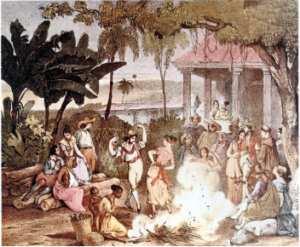ARC Fellows: Sound Reproduction as Biological Reproduction
Submitted by our 2019 ARC Fellow Team:
Delia Casadei & Kim Sauberlich (Music)
When we talk of the reproduction of sound, or of music, we usually mean either a musical score–perhaps in the Western script of five-line staffs, clefs and bars–or a sound recording, whether analogue (on an external support like a disc, cylinder, tape) or digital recording. We don’t usually consider sound “reproduction” in relation to biological reproduction–the sort involving, for example, sex, embryos, mothers, fathers, to say nothing of the asexual reproduction of cells, bacteria, and viruses.
During this semester, we have explored the idea that, in fact, the reproduction of music and of sound through scores and recordings has had a deep kinship with the reproduction of life forms. Let’s put this more strongly: our hypothesis has been that when we talk about the technological reproduction of sound and music (scores, transcriptions, cylinders, discs) starting from the 19th century, we are always already talking about the history of biological processes: procreation, filiation, intercourse, contagion, and propagation of species. Certain sounds and certain musics become signifiers of lives that need to be preserved and made reproducible in turn, or conversely, that are to be discontinued, or let die.
Kim works on 19th century Brazil and the umbigada, a dance gesture proper to the lundu, the first dance of African influence to become a staple of white urban entertainment in the 1820s and 30s. The umbigada’s popularity was described in terms of a dangerous contagion, and became a signifier of interracial sex (specifically the sex between a white woman and a black slave).
The musical reproduction of a black dance (for examples in piano and guitar scores for domestic use, or its repeated mentions in legal court cases from the time) went hand in hand with the fear of black contagion and the fear of miscegenation through interracial sex. In Kim’s project, then, music–so often a metaphysical signifier of an escape from the strictures of language, or a tool for redemption in the face of political, legal, and medical limitations–takes on a dark political function. It is a discourse that precedes, and anticipates, the medicalization and scientific discourse around race in Brazil, but also, perhaps, a force that keeps the complex reproductive and racist mechanisms of Brazilian politics partly unspoken to this day.
 While Kim thinks of music as a pre-verbal disciplining discourse on race, Delia begins her inquiry precisely from the term reproduction and its late nineteenth-century slippages. She investigates the English-speaking worlds of the late nineteenth and early twentieth centuries and asks how sound recording itself (and the language used to talk about sound recording) intersects with notions about biological reproduction. In her research, she found that modern scientific understandings of the term “reproduction”–together with nineteenth-century ways of violently controlling procreative practices–becomes widespread from the time in which phonography began. Indeed, that may be why we talk about sound recording as “sound reproduction,” a term used to talk about phonography since at least the 1890s. She also finds this linguistic reproductive lineage in the peculiar terminology about the reproduction of vinyl discs in the 1950s and 60s, asking about the significance of terms such as “master,” “mother,” “daughter” to refer to the various stages in the manufacture of vinyl discs.
While Kim thinks of music as a pre-verbal disciplining discourse on race, Delia begins her inquiry precisely from the term reproduction and its late nineteenth-century slippages. She investigates the English-speaking worlds of the late nineteenth and early twentieth centuries and asks how sound recording itself (and the language used to talk about sound recording) intersects with notions about biological reproduction. In her research, she found that modern scientific understandings of the term “reproduction”–together with nineteenth-century ways of violently controlling procreative practices–becomes widespread from the time in which phonography began. Indeed, that may be why we talk about sound recording as “sound reproduction,” a term used to talk about phonography since at least the 1890s. She also finds this linguistic reproductive lineage in the peculiar terminology about the reproduction of vinyl discs in the 1950s and 60s, asking about the significance of terms such as “master,” “mother,” “daughter” to refer to the various stages in the manufacture of vinyl discs.
By looking at scientific journals about reproductive technologies and trade journals about sound reproduction, she asks how both the language about and the processes associated with sound reproduction work according to (and whether they can subvert) racist, patriarchal, and colonial logics.
Delia Casadei’s research focuses on the relationship between voice and politics in Italian 20th-century music. Her doctoral thesis examined this relationship by way of Milan in the 1950s-70s, where she investigated a question usually asked about Italian operatic production in the nineteenth century, namely: what is the political role of language—spoken, written, heard, and misheard—in the musical history of a country that has been mythologized for its sheer vocal prowess? She is currently expanding this thesis into a book that argues that key political theories formulated in Italy between the 1950s and today (from Gramsci to Operaismo, Agamben, Esposito, and Cavarero) are informed by political ideologies of the voice—from the plebiscitary metaphor of vox populi, vox dei to more specific notions of orality tied to the use of recording technology.
Kim Sauberlich is a PhD student in Music History and Literature. Kim received her BMus and MMus degrees from King’s College, London before she came to Berkeley. Kim is interested in the ways in which music acquires meaning in new environments and aims to produce research that is informed by a recent body of work on cultural mobility. With a penchant for cultural history and critical theory, Kim’s work also seeks to address some of the complex interactions between musical production, verbal discourse and political practice.
Note: Over the course of the spring semester, each 2019 ARC Fellows team will submit a short blog post about their project and findings. We hope you will enjoy these short readings! The Fellows Program advances interdisciplinary research in the arts at UC Berkeley by supporting self-nominated pairs of graduate students and faculty members as they pursue semester-long collaborative projects of their own design. To learn more about the program, click here.

